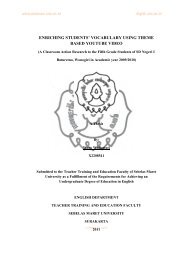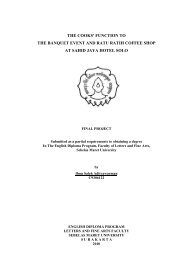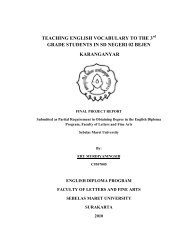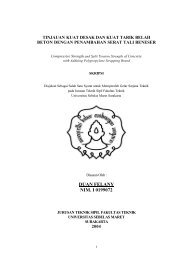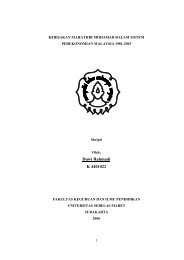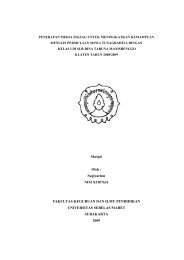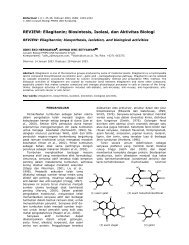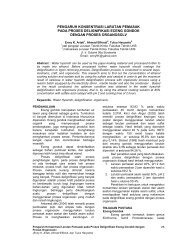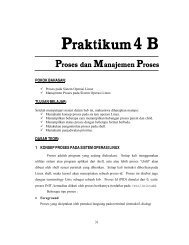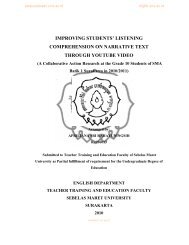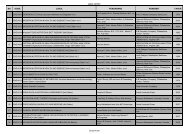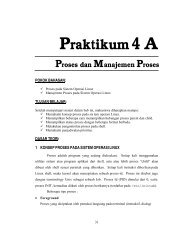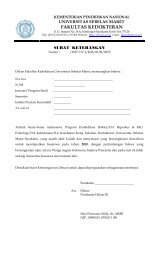ISSN 2087-3940 (PRINT) | ISSN 2087-3956 ... - Biodiversitas
ISSN 2087-3940 (PRINT) | ISSN 2087-3956 ... - Biodiversitas
ISSN 2087-3940 (PRINT) | ISSN 2087-3956 ... - Biodiversitas
Create successful ePaper yourself
Turn your PDF publications into a flip-book with our unique Google optimized e-Paper software.
42<br />
3 (1): 36-43, March 2011<br />
Table 2. Management objectives of sites selected for management purposes<br />
Management objective<br />
Sites 7, 10 Site 18 Site 5 Sites 16, 17<br />
Category VI Category Ib Category IV Category II<br />
Scientific research 3 3 2 2<br />
Wilderness protection 2 1 3 2<br />
Preservation of species and genetic diversity (biodiversity) 1 2 1 1<br />
Maintenance of environmental services 1 1 1 1<br />
Protection of specific natural / cultural features 3 – 3 2<br />
Tourism and recreation 3 2 3 1<br />
Education 3 – 2 2<br />
Sustainable use of resources from natural ecosystems 1 3 2 3<br />
Maintenance of cultural/traditional attributes 2 – – –<br />
Note: 1 = Primary objective; 2 = Secondary objective; 3 = Potentially applicable objective; – = not applicable.<br />
Site priorities for tourist uses<br />
Sites classified as first category sites (sites 1, 3, 8, 11,<br />
13 and 15) are recommended as tourist use sites with<br />
management of the sensitive resources and non<br />
consumptive recreational activities like swimming, diving,<br />
boating, surfing, wind -surfing, jet skiing, bird watching,<br />
snorkelling, etc. Locations of recreational activities could<br />
have a carrying capacity of up to 6000 dives per site per<br />
year (Roberts 1997) while in the sensitive locations, it<br />
should not exceed 500 dives per site per year (Chadwick-<br />
Furman 1996). However, effective diver education<br />
programs can allow coral reef managers to increase<br />
carrying capacities (Medio et al. 1997), also mooring buoys<br />
and the management of the number of vessels using<br />
mooring buoys with respect to time and location are other<br />
effective tools coral reef managers use in reducing the<br />
anchor and diver damage to coral reefs. Management of<br />
sensitive habitats in first category of tourist use sites<br />
includes protection of rarity for sites 1, diversity and rarity<br />
for site 3, fragility for site 8, diversity for site 11 and<br />
typicalness for site 13. Second category sites (sites 2, 4, 6,<br />
9, 12, 14, 19 and 20) are recommended as tourist use sites<br />
with non consumptive and managed consumptive<br />
recreational activities like fishing. Diver carrying capacity<br />
of these sites could approach 6000 dives per site per year.<br />
Site 4 having the lowest sensitivity significance and most<br />
minimum values with respect to every sensitivity criterion<br />
is suggested to allocate a part of it for building an artificial<br />
reef to restore the damaged ones (Ammar 2009a).<br />
Site description<br />
Damaged reef flat in site 1 is due to the absence of reef<br />
access points to deep water. Ammar (2009b) indicated the<br />
importance of reef access points in his assessment of some<br />
coral reef sites along the Gulf of Aqaba, Egypt. Increased<br />
algae and sands in site 2 with increased dead corals agree<br />
with Pearson (1981) and Nezali et al. (1998) that algae are<br />
among the most important factors which can influence<br />
coral recolonization. The high percentage cover of the<br />
hydrocoral Millepora dichotoma at 1-5m depth in Marsa<br />
Nakry as well as in other sites having that species, agrees<br />
with the finding of Ammar (2004) that, Millepora sp. (a<br />
hydrocoral) prefers high illumination and has a strong<br />
skeletal density to tolerate strong waves. The relatively low<br />
sensitivity significance in spite of the presence of the<br />
threatened species (the blue spotted stingray Taenura<br />
lymma) in sites 1 and 3, indicates the importance of using a<br />
particular criterion when dealing with a particular<br />
management purpose. The green turtle Chelonia mydas<br />
found in site 7 is categorized as a taxon having an<br />
observed, estimated, inferred or suspected reduction of at<br />
least 80% over the last 10 years or three generations,<br />
whichever is the longer (IUCN 2002). The lower recorded<br />
amount of dead corals in site 10 (Sharm El Loly) though it<br />
is highly used by fishing boats, is due to the fact that these<br />
boats anchor on the inlet terminal, away from the reef and<br />
go to open water through the middle of the inlet. Reporting<br />
juveniles of the vulnerable organ pipe coral Tubipora<br />
musica in site 17 (Wadi El-Mahara) is the reason of<br />
increased sensitivity significance with respect to rarity in<br />
that site. Ammar (2005) categorized the organ pipe coral<br />
Tubipora musica as vulnerable according to IUCN (2001),<br />
as there is an estimated population size reduction of ≥ 50%<br />
over the last 10 years, based on the index of abundance and<br />
the decline in area of occupancy. Site 18 having a<br />
mangrove ecosystem, a seagrass ecosystem and a coral reef<br />
ecosystem integrating together helped to increase most of<br />
the selection criteria, in turn increasing the overall<br />
sensitivity significance. Broody (1998) stated that selection<br />
criteria help to provide a rational basis for choosing among<br />
potential sites.<br />
CONCLUSIONS<br />
The present study approached for the first time a<br />
numerical total sensitivity significance score for each site<br />
to select a site that is much appropriate with most of the<br />
used criteria. This is important to classify a group of sites<br />
to be suitable either for tourist use or management<br />
purposes. Since priorities for site selection differ from one<br />
sensitivity criterion to the other and from the total<br />
sensitivity significance, it is important, after selecting a site<br />
for management (using the total sensitivity significance), to<br />
specify the appropriate criterion for deciding the<br />
appropriate management purpose per site. Sites selected for<br />
management (protection) purposes are categorized as<br />
belonging to the following protected area categories: sites<br />
7, 10 (category vi), site 18 (category ib), site 5 (category<br />
iv), sites 16, 17 (category ii). Sites selected for tourist uses<br />
are classified into 2 categories: 1- First category sites (sites



